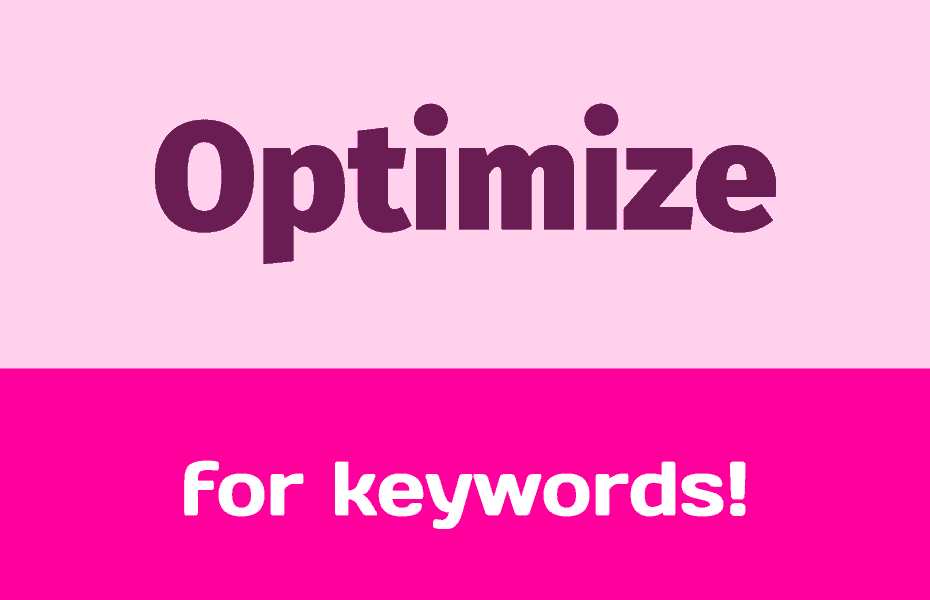Finding the right keyword, or keywords, is fundamental to your Search Engine Optimization (SEO). Your keywords serve as the pillar on which you build your SEO strategy! You will also be able to check on your keywords over time to see if they are ranking and making your website rank better as a whole. By improving your website’s rankings, you’ll generate more traffic to your website and increase potential customers that see your offerings. We will publish a full article this September 2021 on keywords and how to find them so check back soon!
For those that already have or know the keywords that they want to rank for, you want to make sure that your post is optimized for search engines like Google, Bing, and Yahoo, so that you have a better chance to appear in search results. Although there are many different criteria that go into making your website rank for a keyword, the first step is on-page optimization!
optimizing the HTML
This one may seem obvious, but the first step in optimizing a page or post for a keyword is to include that keyword at least once in the content of that page or post. It’s also commonly believed that you should also feature your keyword in other parts of your page, including:
- URL
- TITLE tag
- META description tag
- H1 title tag
- H2 title tag
- H3 title tag
- ALT text of an image on the page
The TITLE tag is the most important place to include your keyword for SEO purposes. The TITLE tag is an HTML code tag that allows you to give a web page or post a title, and this title can be found in the browser title bar as well as search engine results pages (SERP). It is limited to roughly 60 characters in length, and it’s limited space is one of the main reasons why it’s a good space to dedicate to your keywords.
Post Title
The title of your post is automatically used to generate your H1 tag (H1 and other heading tags are used to help Google understand the structure of your blog post), your URL (also known as the permalink, and the TITLE tag that we mentioned earlier. The title you use does NOT need to correspond exactly to your main keyword, and you can also edit the TITLE tag to not be the same as your post title in your blog post’s SEO settings.

Post Text
The post text is the bulk of your text, and you should use your keywords AT LEAST once in the text of your post. You can even highlight the keywords by making them bold to make it easier for your readers to find!
A question we commonly receive is “how many words should my blog post be for SEO purposes?”. This is a difficult question to answer, but we recommend that your post be at least 300 words long. The reasoning behind this is that it takes a few hundred words to make your blog post interesting for your readers, and Google knows that! Therefore, to make sure that Google and other search engines index your page, you want to show them that it is interesting enough that people would want to read it and receive good information out of it. This is not a hard and fast rule though, and if you are writing on an extensive topic or a topic that is covered by a lot of other blog posts, more words may give you a better chance at ranking your blog post!

How many times should you repeat your keyword
Google is adamant that they don’t have a keyword density limit. The best advice we can give is to make your text be natural. What you want to avoid is not using your keyword at all, and also the complete opposite, which is keyword stuffing. Google’s algorithms are smart enough to know that keyword stuffing is bad and may mark your post as low quality.
H2, H3, H4
When you add the Title for your blog post, this is automatically associated as your H1. To optimize your blog post even further, it is a great idea to add your keywords to H2 and H3 title tags too.
Remember from earlier that H2, H3, H4, etc. are heading tags to help Google understand your post structure. They represent a structure of titles and sub-titles. Typically, these title tags are also styled from larger to smaller text size too. You should use a H2 after an H1, and H3 after H2, etc.
The easiest way to add the H1, H2, H3, etc. tags in your blog posts is to use the Heading block!

Image aLT text
The ALT text of an image used to be for browsers that don’t show images. Now, they are most helpful for visually impaired users to tell them what the image they would be seeing is.
ALT text is also used by Google to understand what the content of an image is. Therefore, it is good SEO practice to use your keywords in at least one image on your page or post! You can now edit the ALT text without ever leaving the blog post editor!

The Conclusion
By choosing a good title for your post and following these simple guidelines when writing your blog post or building a new page on your website, you can complete a great deal of optimization for your on-page SEO!


